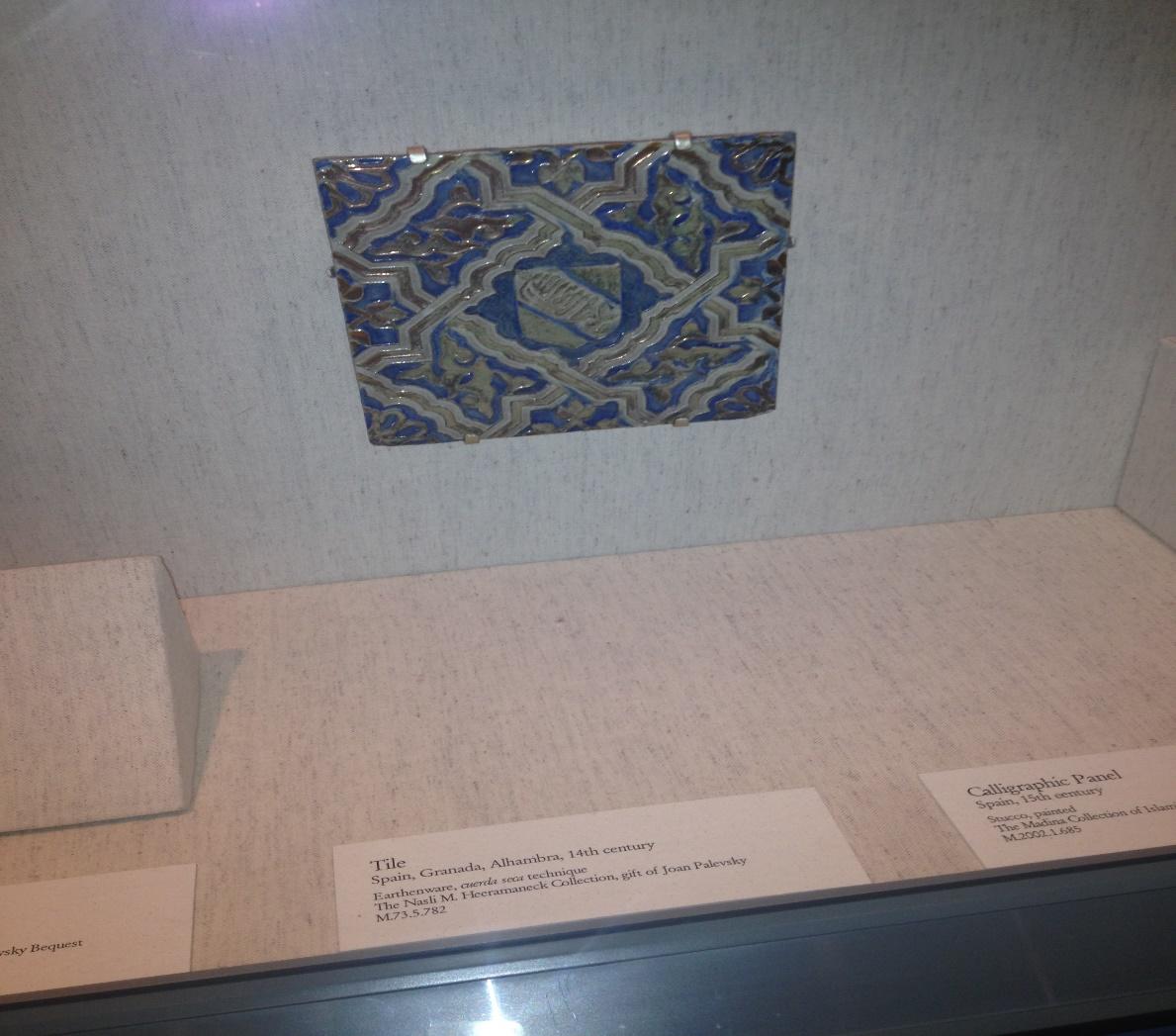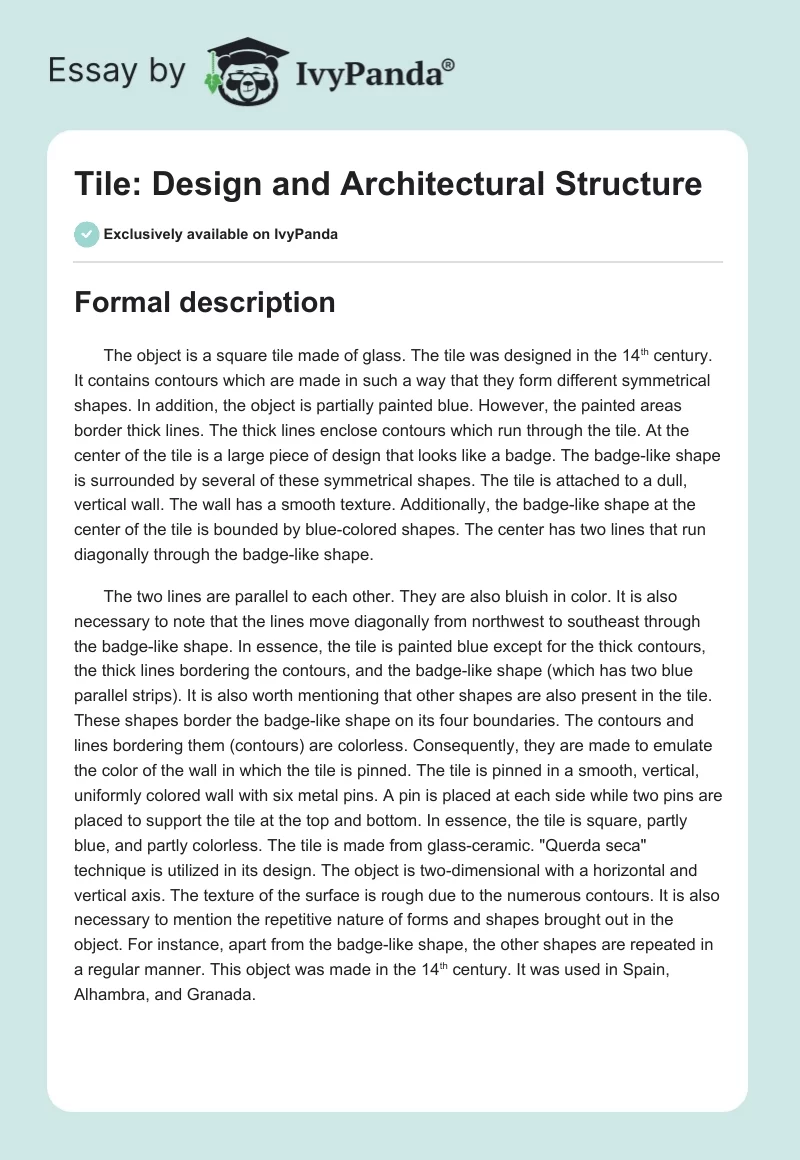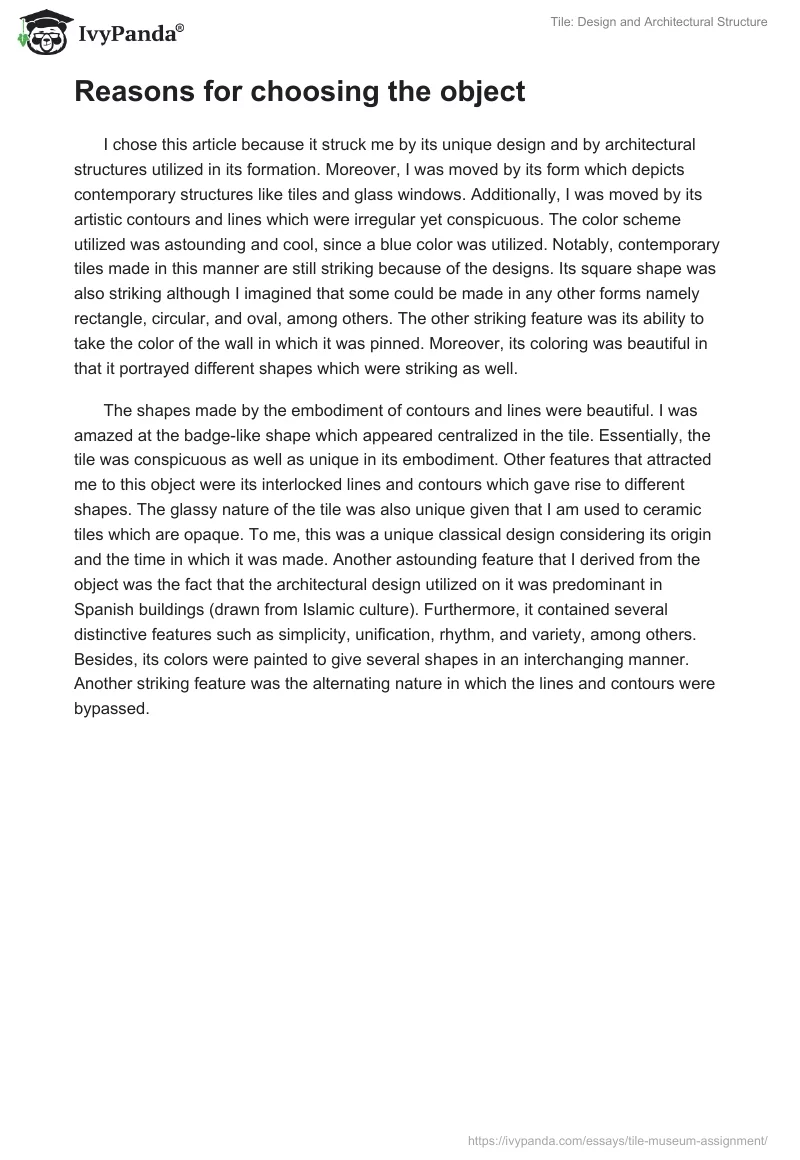Formal description
The object is a square tile made of glass. The tile was designed in the 14th century. It contains contours which are made in such a way that they form different symmetrical shapes. In addition, the object is partially painted blue. However, the painted areas border thick lines. The thick lines enclose contours which run through the tile. At the center of the tile is a large piece of design that looks like a badge. The badge-like shape is surrounded by several of these symmetrical shapes. The tile is attached to a dull, vertical wall. The wall has a smooth texture. Additionally, the badge-like shape at the center of the tile is bounded by blue-colored shapes. The center has two lines that run diagonally through the badge-like shape.
The two lines are parallel to each other. They are also bluish in color. It is also necessary to note that the lines move diagonally from northwest to southeast through the badge-like shape. In essence, the tile is painted blue except for the thick contours, the thick lines bordering the contours, and the badge-like shape (which has two blue parallel strips). It is also worth mentioning that other shapes are also present in the tile. These shapes border the badge-like shape on its four boundaries. The contours and lines bordering them (contours) are colorless. Consequently, they are made to emulate the color of the wall in which the tile is pinned. The tile is pinned in a smooth, vertical, uniformly colored wall with six metal pins. A pin is placed at each side while two pins are placed to support the tile at the top and bottom. In essence, the tile is square, partly blue, and partly colorless. The tile is made from glass-ceramic. “Querda seca” technique is utilized in its design. The object is two-dimensional with a horizontal and vertical axis. The texture of the surface is rough due to the numerous contours. It is also necessary to mention the repetitive nature of forms and shapes brought out in the object. For instance, apart from the badge-like shape, the other shapes are repeated in a regular manner. This object was made in the 14th century. It was used in Spain, Alhambra, and Granada.
Reasons for choosing the object
I chose this article because it struck me by its unique design and by architectural structures utilized in its formation. Moreover, I was moved by its form which depicts contemporary structures like tiles and glass windows. Additionally, I was moved by its artistic contours and lines which were irregular yet conspicuous. The color scheme utilized was astounding and cool, since a blue color was utilized. Notably, contemporary tiles made in this manner are still striking because of the designs. Its square shape was also striking although I imagined that some could be made in any other forms namely rectangle, circular, and oval, among others. The other striking feature was its ability to take the color of the wall in which it was pinned. Moreover, its coloring was beautiful in that it portrayed different shapes which were striking as well.
The shapes made by the embodiment of contours and lines were beautiful. I was amazed at the badge-like shape which appeared centralized in the tile. Essentially, the tile was conspicuous as well as unique in its embodiment. Other features that attracted me to this object were its interlocked lines and contours which gave rise to different shapes. The glassy nature of the tile was also unique given that I am used to ceramic tiles which are opaque. To me, this was a unique classical design considering its origin and the time in which it was made. Another astounding feature that I derived from the object was the fact that the architectural design utilized on it was predominant in Spanish buildings (drawn from Islamic culture). Furthermore, it contained several distinctive features such as simplicity, unification, rhythm, and variety, among others. Besides, its colors were painted to give several shapes in an interchanging manner. Another striking feature was the alternating nature in which the lines and contours were bypassed.

How the object relates to themes
Appropriation
The object can be related to numerous themes. For instance, it has ornamental features that portray Islamic culture in them. The first theme which is observable in the object is appropriation. This is observable in its embodiment which draws from different cultures. It can be observed that Islamic culture is utilized in the repetitive nature of shapes. However, this is intertwined with the Spanish local culture which does not give repetition a priority. Throughout the object, it can be observed that its design and painting draws from a variety of cultures. For instance, Islamic culture values unification. Moreover, it does not approve the use of many colors in any design. It can be noted that the object portrays indigenous artistic heritage with a combination of Islamic art.
It can be noted that various cultures have influenced the making of this object. As mentioned earlier, purely Islamic culture would require uniform art. Islam prohibits irregular artworks. However, it can be noted that different shapes are made in the object. For instance, there is a badge like a shape in the center of the tile. In addition, the badge is embodied with different artifacts. Besides, it is bordered by a repetition of similar shapes. However, it is important to note that these shapes are not equal in size. However, Islamic culture required that the shapes in any object be made to reflect unity. It is therefore obvious from the structural design of the object that the theme of appropriation is utilized predominantly. In essence, no single culture was utilized autonomously in making this object.
Ornament
The other theme utilized predominantly is that of ornament. The object is structured to reflect its beauty and coolness. It portrays self-assurance given the color which is utilized in it (blue). Its ornamental features are observable in the design of the badge-like shape with the design in its center. The theme of ornament or adornment is also portrayed in the pattern created with the contours and lines which make the shapes. Moreover, this is also observable in the way the tile has been painted around the badge-like shape to give striking shapes. The whole object is adorned with striking features that portray the ancient Islamic culture and beauty of ancient architectural designs. The theme is also evidenced in the fact that modern tiles have also emulated their technique in making contemporary structures. Additionally, it should be noted that the object portrays delight in ancient culture and design through the adornment of the tile. Effectively, it is observable that this piece of artwork is unique and conspicuous in both its design and structure. It is, therefore, essential to note that the theme of ornament is utilized carefully to show the uniqueness of this object.


